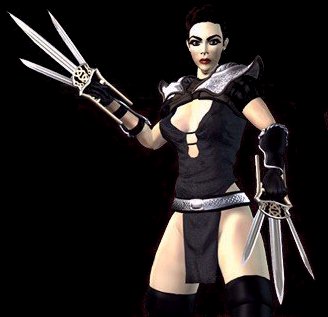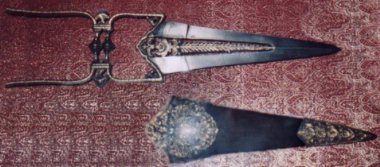
KATARS

The
Katar is often refered to as a "punch dagger", it has a H-shaped grip with the hand holding the crossbar whilst it is used with a thrusting motion. Associated with the Hindu peoples of India, katars became widespread.
There
are many different forms of katar, from the plain to the highly decorated, with various grips and numbers of blades. A few of the myriad types are shown here. Click on each picture to view an enlargement.

This is a high quality version of the most common katar type, note it has four
crossbars instead of the usual two. Also pictured is the sheath, which is red velvet.
This example is housed in the Leeds Armouries and dates from the late 18th century.

A nice piece that's in mint condition. No frills, but a sturdy design
and a long blade for a little extra reach.
This example is housed in the Leeds Armouries.

An interesting example with a curved blade. This is unusal as curved blades are
usually reserved for slashing weapons not for those designed for stabbing attacks.
From a private collection.

The blade on this katar has a small elephant's head chiselled on both sides. The blade
is inscribed in Hindi with onwners name, the Rajah of Rajaha and the date 1907.
This weapon is housed in the Leeds Armouries.

The blade, the centre of which is pierced, chiselled and gilt has a swollen armour-piercing tip.
The elaborate hilt is finely gilt and the red velvet covered scabbard has gilded mounts.
This piece is housed in the Leeds Armouries and is from early 19th Century Rajasthan India.

Katars are often used in pairs, prompting the design of this unsual piece.
It consists of two katars, one of which slides alongside the other it's extended hilt,
locking into place for use together or easily separable to form a pair of weapons.
From a private collection.

An example of a twin-bladed katar, this is heavier and longer than the single blades.
Housed at he Leeds Armouries, this piece dates from the 18th century.

Another katar with a double pointed blade, this piece is significantly
larger than the example above and would require strength to weild efficiently.
See the picture on the Leeds Armoury page for a size comparison.

This piece shows the evolution of the katar. The blade has grown longer (prossibly due to
European blades being available through trading) and the back of the hand is protected by a metal plate.
From a private collection.

For comparions purposes, this a pata (commonly called a sword gaunlet).
A much rarer weapon than the katar, patas were a highly evolved form of the same principle.
From a private collection.









